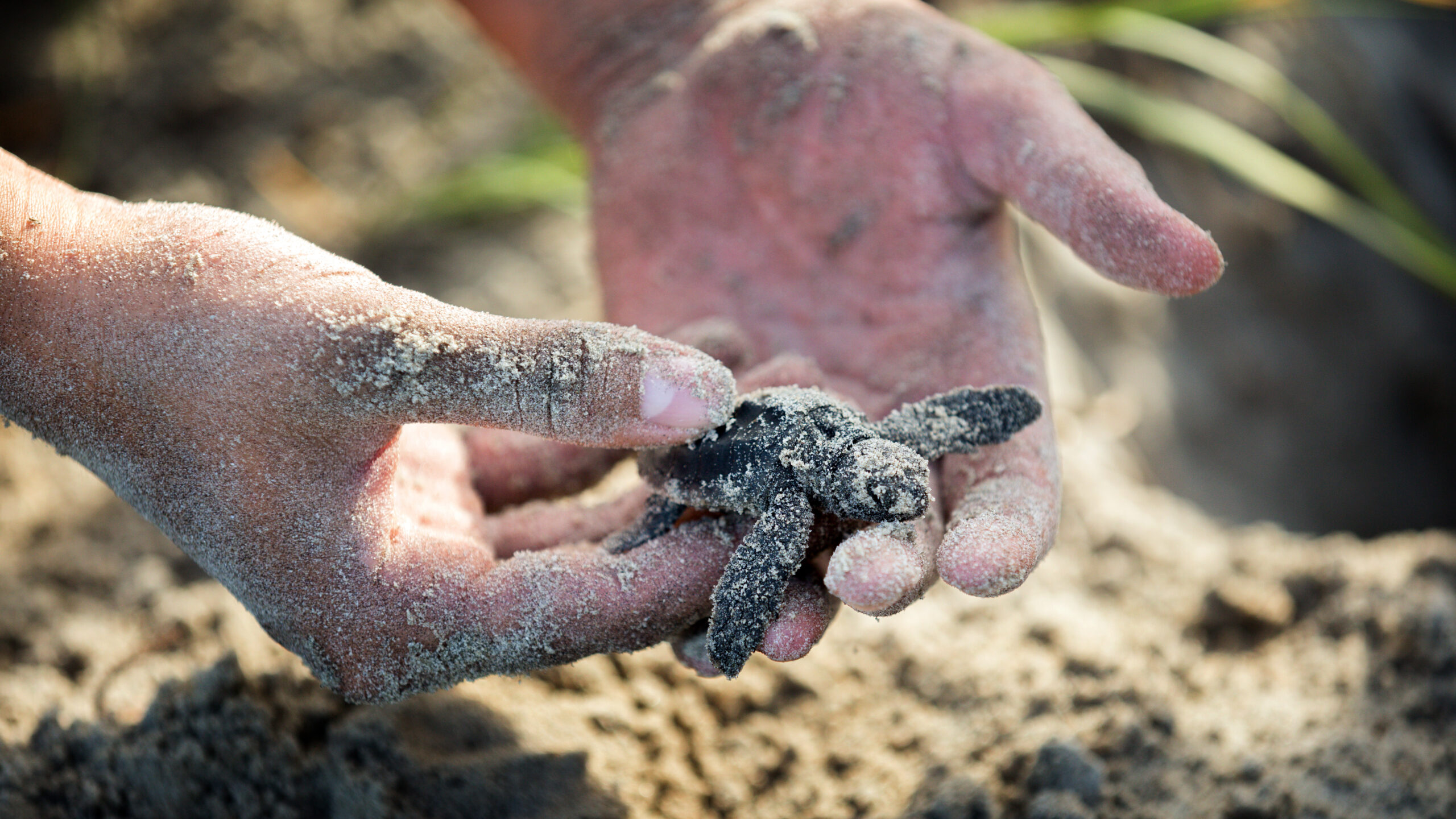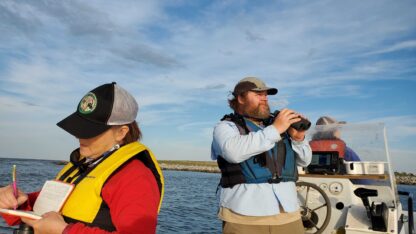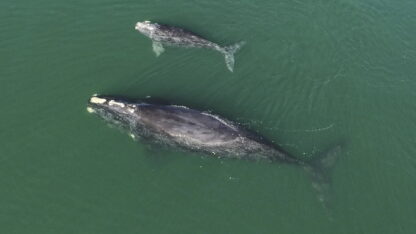In the summer on Jekyll Island, researchers drive slowly up and down the beach all night, the red-shaded headlights on their utility vehicles illuminating ghost crabs and shorebirds.
Macie Broussard, a research AmeriCorps member at the Georgia Sea Turtle Center, checks the time a few hours into her shift in the driver’s seat.
“I usually start drinking my coffee at midnight,” she says.
She and Kara Fadden peer into the darkness, looking for big dark lumps emerging from the waves. Those would be female loggerhead turtles, lumbering up the beach to the soft dry sand to lay their eggs.
We haven’t seen any yet on this night, but we do see wooden stakes lining the beach; each stake marks a sea turtle nest. We also see evidence of nests that have just hatched: hatchling tracks, tiny imprints in the sand, show where, earlier in the night, baby sea turtles burrowed out of their nest and skittered down the beach to the Atlantic Ocean.
happens every summer on Georgia’s beaches, but this year it’s happening more than any other year in recent memory. Researchers like Broussard and Fadden have found more than 3,800 loggerhead sea turtle nests in Georgia, breaking the previous record set in 2016, with a few months left in the nesting season.
South Carolina and North Carolina are also seeing a record number of nests. (Loggerheads tend to lay eggs in three-year cycles; the old records, set in 2016 in all three states, had previously broken 2013 records.) Florida, which sees more loggerhead nests every year than the other three states combined, doesn’t have 2019 nest numbers yet, but is also having a good year.
It shows that decades of conservation work on loggerhead turtles in the Southeast has made a difference for the threatened, long-lived, somewhat mysterious species.
Sound Of The Summer
On Ossabaw Island, a nature preserve near Savannah, there are so many nesting turtles that wildlife biologist Mark Dodd can point out one spot that’s gotten crowded.
“You can see these two nests are almost on top of each other, and then a third turtle came and crawled right across both of them,” he says. “You have to have pretty high nesting density for that kind of thing to happen, so it’s really fun to see that. Not something we’ve seen in the past very frequently.”
Dodd coordinates the sea turtle program at the Georgia Department of Natural Resources, including working with turtle techs like Breanna Sorg, who is should-deep in the sand, digging into a sea turtle nest.
They have this life history which is spectacular. They’re going to go out in the high seas. And you think, ‘what’s the chance that something so fragile and small could ever grow up to be a 300 pound loggerhead.
Mark Dodd, wildlife biologist
She’s excavating the nest a few days after it hatched, to count hatched and unhatched eggs, and dead or alive hatchlings. Data, including genetic samples, get collected on every nest in order to track how loggerheads are doing, and model future population scenarios.
As Sorg digs, she finds a straggler, a hatchling that missed the rush when the rest of its siblings left the nest.
“He’s spunky,” Sorg says as she holds the little turtle.
It’s dark grey with big eyes. Just a few inches long, it churns its flippers in her hand, ready to start its sprint to the ocean.
“It never gets old,” says Cayleigh Quick, the other turtle tech living on Ossabaw for the summer. “Look how cute, oh my gosh.”
They put the little turtle in a bucket to keep it from heading off in the wrong direction or getting eaten before they can finish inventorying its nest. It rattles around the bucket, wanting to scramble for the water. The sound of it scraping against the plastic sides is a sound of the summer, says Dodd. (He also labeled the buzzing of the utility vehicles the turtle techs use to navigate the island as another sign that summer has come to Ossabaw.)
Dodd, who has worked on sea turtles in the Southeast for 30 years, more than 20 of those in Georgia, has seen nest numbers at their very lowest – that was in 2004 – and the upward trend since then.
Seeing A Problem And Turning It Around
Researchers realized in the 1970s that something was going wrong with the loggerheads here.
Naturalist Carol Ruckdeschel, who’s lived on Cumberland Island for decades, necropsied dead turtles that were washing ashore, and figured out they were drowning.
“They get caught in shrimp nets. And they’ve got to breathe air,” she says. “They get caught and they just can’t breathe air, and so they die in the net.”
Ruckdeschel organized the Sea Turtle Stranding and Salvage Network, now coordinated by the National Oceanic and Atmospheric Administration, which tracks sea turtles that wash up injured or dead.
Another problem for the turtles here was happening before they even reached the ocean to encounter shrimp trawlers: wild hogs, raccoons, and even humans, were raiding their nests for eggs.
So the Department of Natural Resources and its partners started protecting the eggs with heavy plastic screens over nests.
For the shrimpers, a piece of equipment called a turtle excluder device (TED), implemented in 1991 – though getting everyone in compliance took longer than that – that gives turtles a way out of the trawl.
TEDs were developed by a Darien fisherman named Sinkey Boone, and Dodd says the technology is now used all over the world. The device is a metal grid placed in the net. Little things like shrimp go through it, but the grid blocks the big turtles, and they can get out through an escape hatch.
Dodd says the TEDs have helped; far fewer turtles are washing up dead on the beaches. It also helped that the shrimp fishery has shrunk here.
“Around the mid-90s things actually started to turn around,” he says.
Nesting numbers didn’t hit rock bottom until 2004, and Dodd says there was concern about losing loggerheads in Georgia; there were fewer than 400 nests in the whole state. This year, there’s much more than that just on Ossabaw Island.
The Beginning Of A ‘Spectacular’ Life History
The turtle techs finish excavating the nest on the beach, and it’s time to let the hatchling go. Sorg carries it down toward the water. It waves its flippers, ready to start swimming.
”He’s like, ‘I want to go, but this is air, not water,’” Sorg says.
She puts the turtle down on the sand, and it scuttles down to the waves. Once it hits the water, the tiny animal starts swimming hard, but we don’t lose sight of it right away.
“We’ll see him,” says Dodd. “You try to keep him as long as you can.”
If we act in time, before populations reach critical low points … there is hope that we can stabilize populations and help them move toward recovery.
Barbara Schroeder, sea turtle coordinator at NOAA
As the turtle paddles, it sticks its head up for air, a tiny triangle breaking the surface of the waves. Dodd says the little loggerhead, heading straight out into the Atlantic Ocean, won’t stop swimming for at least 30 miles.
“This is really cool, because this is the beginning,” he says. “They have this life history which is spectacular. They’re going to go out in the high seas. And you think, ‘what’s the chance that something so fragile and small could ever grow up to be a 300-pound loggerhead.’”
Most don’t make it. Maybe one out of every couple-thousand hatchlings survives the 30-plus years to adulthood. But if this little one we’re watching does live, and if it’s a female, it could be back here on Ossabaw Island to lay eggs in a few decades.
As the hatchling paddles out, Dodd wishes it well.
“Have a good life,” he says. “See you in 35.”
Learning From Loggerheads
Of the seven species of sea turtles, five of them spend at least some time on Georgia’s coast. Loggerheads nest here in by far the highest numbers, and while they live around the world, the biggest nesting population of loggerheads is here in the Southeast. The other large nesting population is in Oman, but that one is declining, according to NOAA.
“This is a mecca for loggerhead nesting,” says Joe Pfaller, research director of the Caretta Research Project. His group works on turtles at Wassaw National Wildlife Refuge, another Georgia barrier island near Savannah.
No one really knows how many sea turtles there used to be, Pfaller says, but reports from the Christopher Columbus era describe the sea in the Caribbean being crowded with turtles.
“Hethought he could walk to the island on the backs of turtles they were so dense. So there is a pretty strong likelihood that there were a lot of turtles out there,” Pfaller says.
We’ll probably never get back to those kinds of turtle populations, and Pfaller says sea turtles will always need some kind of protection, both from past threats, like shrimp trawlers, and from emerging ones, like new fisheries, plastic in the ocean and human-caused climate change.
Climate change is a threat in a couple ways, says Pfaller, since sea level rise could wipe out turtle nesting beaches – at least in places where shorelines are fortified by things like sea walls – and rising temperatures could throw off the sex balance of the species. (The sex of the eggs is decided by temperature; warmer temperatures mean more females.)
Still, the progress with the loggerheads here in Georgia has lessons for other conservation work. One moral of the turtle story is being proactive, to not wait until an animal – especially one with such a long life — is threatened with extinction to start trying to save it.
“If we act in time, before populations reach critical low points, and if we focus on significantly reducing human-caused threats, there is hope that we can stabilize populations and help them move toward recovery,” says Barbara Schroeder, sea turtle coordinator at NOAA.
The Boil
It also doesn’t hurt that a lot of people love sea turtles.
On Jekyll Island, the night patrol comes across a nest hatching, just in time for a couple tour groups to see it happen.
The crowd lets out some oohs and ahhs, but mostly watches in quiet as dozens of hatchlings emerge from the sand and scurry down the beach in the dark. They try to keep count, but the little turtles move too fast.
“It’s amazing,” says Cindy Langley, who’s visiting Jekyll from Vermont. She’s been tagging along with the night patrol as they cruise the beach looking for nesting mothers. But seeing the nest hatch – it’s called a boil, since the hatchlings bubble up out of the sand – that’s not something she says she pictured getting to witness.









